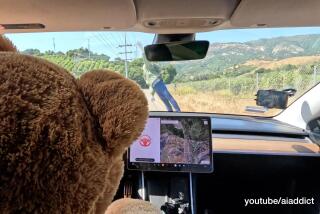Advanced Technology Aims to Make the World Safer for Driving
- Share via
Since the introduction of the padded dashboard to improve occupant safety in cars during the late 1950s, auto makers have made remarkable strides in adapting new technology to reduce injury and death on the highway.
Innovations being introduced in current models are a measure of the priority society has placed on auto safety, an issue that at one time was carefully avoided by the auto industry.
In the next several years, a broad range of safety devices will filter into the mass market from their place in luxury vehicles, improving safety and the ability to avoid crashes for millions of Americans.
And the near-term improvements are just a taste of the tremendous strides that exotic systems could make in the distant future, helping motorists avoid accidents and survive collisions that would certainly be fatal in today’s vehicles.
Enhanced air bags, lighting systems, tires, vehicle structure, vision systems, fuel-containment mechanisms and collision force-reduction systems will all make motoring a safer experience, experts predict.
In the near term, new-car buyers will get the benefit of increasingly intelligent air bags that deploy during accidents with a force that varies based on occupants’ size and their proximity to the steering wheel.
Side-impact bags, which provide additional head and chest protection, will move from their current availability in high-end models into all kinds of vehicles, says Adrian Lund, senior vice president for research at the Insurance Institute for Highway Safety in Arlington, Va.
“This is going to be very important in single-vehicle crashes where a car slides into a pole or a tree,” Lund said. “Tests indicate that these bags are able to greatly reduce head injuries.”
The bags are fast-reacting, able to inflate fully within 25 to 30 millionths of a second after the initiation of a crash.
Another key area of near-term safety improvement will be active systems to prevent and reduce whiplash in rear-impact accidents. Saab has introduced a system that pushes the head restraint up and forward as the weight of a passenger presses against the seat back in a rear-end accident. Its Swedish rival Volvo, meanwhile, has taken the approach of having the seat back move rearward, reducing the difference in speed between the torso and head during an accident. That motion differential is what causes whiplash.
German makers Mercedes-Benz and BMW recently introduced head restraints that automatically go up or down, based on how far back a front seat is moved from the dashboard.
Daytime-running lights, now standard on General Motors vehicles, will likely be adopted universally, Lund predicts. Xenon lights, a brighter and more focused illumination system, will move from models offered by Mercedes, BMW and Ford’s Lincoln luxury division to become standard equipment. This year, GM’s Cadillac division will introduce the first night-vision system, in which images beyond a driver’s normal visual range are projected onto the windshield.
Run-flat tires, currently an expensive feature offered only on selected models and in the aftermarket, become more common and may one day eliminate accidents caused by blowouts.
But the biggest strides in technology lie in the distant future.
Radar-controlled braking systems may allow vehicles to stop automatically before a frontal crash becomes inevitable. Even if engineers decide to avoid allowing mechanical systems to take over from a driver, such systems could still alert drivers to pay attention.
Similarly, drowsiness sensors will monitor the driver’s eye movement or inputs to the steering wheel and sound an alarm when they perceive that the driver is falling asleep.
Automatic systems to notify emergency personnel after a crash are likely to be perfected. Already, in vehicles equipped with GM’s OnStar system, control centers are notified any time an air bag deploys; in response, a dispatcher calls the car phone. If nobody answers, authorities are notified and directed to the vehicle’s location using space-based navigation systems.
Without question, engineers will perfect self-sealing fuel systems that will sharply reduce the risk of fires and burns after an accident, says Clarence Ditlow, executive director of the Center for Auto Safety in Washington.
Ditlow says he expects gas tanks to have plastic liners that will prevent fuel spills after accidents. And he called on the auto industry to provide fuses for every electrical circuit in every vehicle--something that is not yet standard--because this would reduce the risk of electrical overloading or short-circuiting, which can lead to fires.
There’s no doubt that active systems with even more far-out technology could make accidents less likely and more survivable. Some far-reaching futurists believe, for example, that vehicles could be equipped with exterior air bags that would cushion the impact of high-speed collisions.
Electronic suspension-control systems could tilt a car or truck and lower its center of gravity when sensors determine that a rollover is imminent. Mercedes has already developed a roll bar that pops into place once it senses that a rollover is likely.
With all such safety improvements, however, Lund worries that some motorists will use them to justify taking greater risks.
“As you make the driving task easier,” he said, “people compensate and drive faster.”
Ralph Vartabedian cannot answer mail personally but will attempt to respond to automotive questions of general interest in this column. Write to Your Wheels, Business Section, Los Angeles Times, Los Angeles, CA 90053.
Good Carma: How to research a vehicle’s safety ratings. Classified, G11







